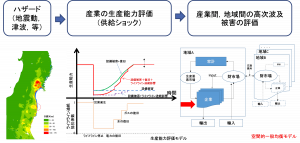Professor Hirokazu Tatano received the Sir Richard Stone Prize of the International Input-Output Association
- Award
Professor Hirokazu Tatano, DPRI, Kyoto University and Prof. Yoshio Kajitani, Kagawa University received the Sir Richard Stone Prize from the International Input-Output Association, Austria for the following paper in August 2020:
- Title of the Award : Sir Richard Stone Prize, International Input-Output Association
- Award Recipients : Yoshio Kajitani, Kagawa University, and Prof. Hirokazu Tatano, Kyoto University
- Paper Title: Applicability of a Spatial Computable General Equilibrium Model to Assess the Short-Term Economic Impact of Natural Disasters, Economic Systems Research, 30(3), pp.289-312, 2018, Kajitani, Y. and Tatano, H.:
- Award Date : August 2020
What is the Sir Richard Stone Prize?
Sir Richard Stone Prize is awarded every other year for the best paper(s) that was submitted and accepted for publication in IIOA’s journal Economic Systems Research in the two consecutive volumes. The prize is donated by Francis & Taylor, the Publisher of the journal.
Sir John Richard Nicholas Stone (1913-1991) was an eminent British economist who in 1984 received the Nobel Memorial Prize in Economic Sciences for developing an accounting model that could be used to track economic activities on a national and, later, an international scale. He is sometimes known as the ‘father of national income accounting’, and is the author of studies of consumer demand statistics and demand modeling, economic growth, and input-output. http://www.econ.cam.ac.uk/Stone/about-sir-richard-stone
Summary of the Paper:
In this paper, the authors provide an important contribution to the literature on the choice of and effectiveness of disaster impacts assessments approaches, with a specific focus on the role of estimated elasticities of substitution relative to the analytical time-frame. They quite effectively situate their research within the context of the relevant literature, and provided an exceedingly clear and concise description of the salient aspects of their model. their work supports the conclusion “that plausible settings can make CGE models suitable for disaster impact analysis, at least for short-run cases.” The jury deemed this paper to be a significant contribution to the model validation literature.






